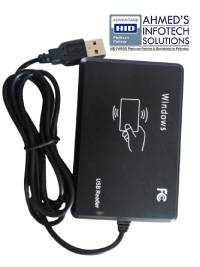Description
The RFID card reader is a device specifically created to access information stored on RFID cards. It uses radio-frequency identification (RFID) technology. This reader is essential in a wide range of applications, offering a secure and convenient method for access control, identification, and data retrieval.
Important Features
- RFID Technology: RFID technology uses radio waves to communicate between the RFID card and the reader. The RFID card contains a small chip or tag that stores data, and the reader is equipped with an antenna to send and receive radio signals.
- Types:
- Contactless Readers: These readers can read RFID cards without physical contact. The users only need to bring their RFID cards into close proximity to the reader for communication.
- Contact Readers: These readers require direct physical contact between the RFID card. The card is inserted into a slot or brought into contact with the reader for data transmission.
- Frequency Range: The RFID operates at different frequency ranges, including low frequency (LF), high frequency (HF), and ultra-high frequency (UHF). The choice of frequency depends on the specific application and the characteristics required, such as communication distance.
For details and buy: +92-309-786-2487
Applications:
-
- Access Control: These are commonly used for access control systems. Individuals present their RFID cards to the reader to gain entry to secured areas.
- Identification: These are used for identifying individuals in various scenarios, such as government-issued ID cards, employee badges, or membership cards.
- Asset Tracking: RFID technology is employed to track and oversee assets in sectors like logistics, inventory management, and supply chain operations.
- Security Features: Mostly are incorporate security features to ensure the integrity and confidentiality of data. Encryption, authentication, and secure communication protocols may be employed to enhance security.
- Integration with Systems: These are often integrated into broader systems, such as access control systems, time and attendance tracking systems, or identity management solutions.
- Mounting Options: These can be wall-mounted, desktop-mounted, or integrated into turnstiles and access gates. It depends on the specific installation requirements.
- Ease of Use: The readers have been created with user-friendliness in mind, enabling users to swiftly and effortlessly verify or gain access using their cards.
- Supports low and high frequency cards such as HID Prox, MIFARE, DESFire, iCLASS, and SEOS
These are versatile devices with applications ranging from access control to identification and asset tracking. The choice of an RFID card reader depends on factors such as the type of RFID cards used, the desired frequency range, security requirements, and the specific application context.
- RFID PVC Card
- RFID Card Printer Price
- HID DigitalPersona 4500 Fingerprint Reader
- Authorized dealer of HID FARGO






Reviews
There are no reviews yet.